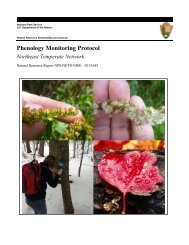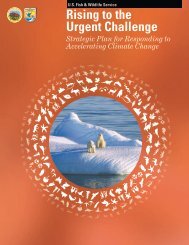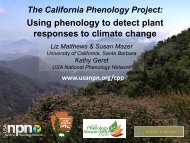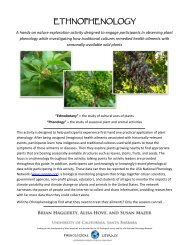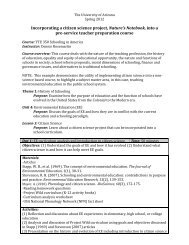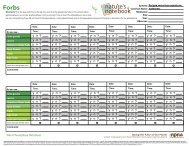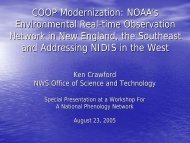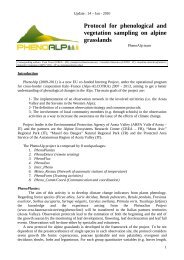The Phenology Handbook - USA National Phenology Network
The Phenology Handbook - USA National Phenology Network
The Phenology Handbook - USA National Phenology Network
You also want an ePaper? Increase the reach of your titles
YUMPU automatically turns print PDFs into web optimized ePapers that Google loves.
Additionally, current and predicted rates of warming might outpace the dispersal rates of many organisms, especially<br />
for the thousands of plant species for which seed dispersal requires particular species of animals to eat<br />
their fruits. If their seed dispersers do not carry the seeds to other habitats, then plants will not be able to colonize<br />
new and potentially suitable habitats.<br />
Lastly, food webs within ecological communities are likely to change when novel species colonize a habitat, potentially<br />
disrupting resource availability for many members of the community. For example, as the number and<br />
abundances of different species in an area change as species move in and out in response to climate change,<br />
the number and types of species competing for the same foods can increase. When this happens, competition<br />
for a rare food resource (such as ripe fruits or newly emerged insect larvae) can become particularly intense.<br />
Under these conditions, the risk of extinction is likely to increase for many species (recall our earlier example of<br />
frugivorous birds competing for ripening fruits in Figure 5).<br />
Temporal responses to climate change: earlier and/or extended phenology<br />
On a temporal scale, at any given location, living organisms respond to the expanding or shifting growing season<br />
by changing their phenological schedules. Thousands of biological records spanning both the globe and the<br />
20th century indicate a nearly ubiquitous shift in spring phenology toward earlier calendar dates. To summarize,<br />
organisms are tracking an earlier start to the growing season by emerging from dormancy earlier (mammals, insects),<br />
migrating earlier (birds, insects, mammals), developing new leaves and stems earlier (plants), and breeding<br />
earlier (mammals, insects, birds, plants). Not surprisingly, similar delays in autumn phenology are occurring<br />
due to a persistent summer—deciduous trees are shedding their leaves later than expected, and birds and mammals<br />
are migrating later in the autumn than normal.<br />
As you can imagine, the consequences of phenological shifts will depend on the level of biological organization<br />
that we investigate, and these consequences may be either positive or negative. For a long-lived individual<br />
tree, for example, leafing out several days earlier each spring may allow it to get a rapid head start in its annual<br />
growth, especially if neighboring trees remain leafless, which would allow its leaves to receive a great deal of<br />
sunlight. On the other hand, if it produces its leaves earlier than any of the other members of its population, it<br />
may be particularly vulnerable to leaf-eating insects (e.g., moth and butterfly larvae, leaf miners, and leaf-cutting<br />
ants) simply because it will be a rare and limited resource for them.<br />
18<br />
<strong>The</strong> Intergovernmental Panel on Climate Change (IPCC)<br />
After decades of scientific discussion about the possibility of global warming, in 1988 the World Meteorological<br />
Organization and the United Nations Environmental Programme created the Intergovernmental<br />
Panel on Climate Change (IPCC). <strong>The</strong> IPCC is a multidisciplinary scientific body that regularly brings together<br />
hundreds of experts from all regions of the world to assess the global climate system. <strong>The</strong>ir efforts are<br />
broadly focused on two topics: the assessment and interpretation of scientific information, and the formulation<br />
of realistic response strategies at national and global levels. <strong>The</strong>ir findings have been published in a<br />
series of ground-breaking Assessment Reports (1990, 1995, 2001, 2007) as well as in a handful of Special<br />
Reports examining topics in greater detail.<br />
<strong>The</strong> IPCC’s First Assessment Report in 1990 played a decisive role in the establishment of an international<br />
treaty for climate change mitigation in 1992, the United Nations Framework Convention on Climate Change<br />
(UNFCCC). <strong>The</strong>ir Second Report provided key input for the negotiations of the Kyoto Protocol in 1997. <strong>The</strong><br />
IPCC received the 2007 Nobel Peace Prize after the publication of its Fourth Assessment Report, which contained<br />
the strongest language to date concluding that “warming of the climate system is unequivocal” and<br />
that “there is very high confidence that the net effect of human activities since 1750 has been one of warming.”<br />
You can learn more about the IPCC online at www.ipcc.ch



